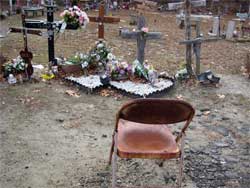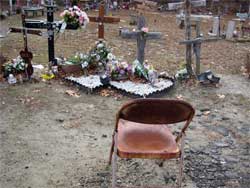 Represents cultural change, according to exhibitor
Represents cultural change, according to exhibitor
KINGSTON, R.I. –June 2, 2009—Randi Scott of East Greenwich is nontraditional in many ways. The 55-year old mother of three returned to college after a 35 year-plus absence and graduated last month from the University of Rhode Island with an undergraduate degree in anthropology. Her work will be exhibited in the Photo Galley of URI’s Fine Arts Center, 105 Upper College Road, Kingston from June 10 to June 26.
She’s using the exhibit to show how our society tries to cope with the increase of mass-casualty occurrences in our country, whether the event is natural, accidental, or terrorist-based. Her research focuses on the spontaneous memorials at the Station Nightclub site in West Warwick where 100 people lost their lives.
She has long been interested in funerary rituals, ceremonial rites and customs and how they help in coping with grief and the processes of healing and closure. She sees today’s rituals around mass casualties to be a culture change. The Station fire memorials are part of that trend.
In the past century, dealing with death has been a private family matter. The public was not invited. Today, Scott sees a movement to community involvement and a growth of sub-cultures. The loss also becomes a community loss (Columbine and the Oklahoma City bombings) as well as the nation’s loss (World Trade Center).
Let’s begin at the beginning. Scott is a member and officer of a volunteer humanitarian organization, Forensic Archaeology Recovery (FAR), which uses archaeological methods and technologies to recover personal effects and human remains from mass casualty sites. FAR was responsible for the recovery efforts at the Station fire.
Brown University Professor Richard Gould, founder and FAR team leader invited Scott to meet him at the Station site in July 2003 five months after the fire. There she saw the beginnings of the memorial, 100 crosses placed in the footprint of the building. Gould suggested to Scott that the memorials could be the beginning of an interesting and important ethnological project. Since then, she has been documenting any and all major and minor changes. She also interviewed about 25 friends or family members of the victims.
“As a student of anthropology, the usual way to look at a change in a culture is literally looking backwards,” the recent URI graduate says. “What a culture has left behind gives us a glimpse as to the what, where, when, and most importantly why a people lived as they did. It is very seldom and unusual to be able to watch a cultural change as it happens and be able to document it. I feel my work at the Station is one of those rare occasions. I also believe that with this project I am crossing the boundaries of many disciplines due to its sensitive and emotional content. In order to make any type of conclusion to what is happening, anthropology, archaeology, sociology, psychology and even the arts are involved.”
Scott says those 100 crosses soon were painted and a butterfly sticker placed on each of them. Mardi Gras beads were added. Names were then scratched into the crosses. Two granite stones engraved with victims’ names were added with two chairs. Eventually a garden that attracts butterflies was designed and planted.
“I thought that the memorials would have a finite life and guessed the harsh New England winter would end them. I was SO wrong,” she says.
“Until a final decision is made to what will become of this site, no true conclusions or results can be made. I do know, however, that this memorial has taken on a life of its own; it is constantly changing. After 6 years the site still takes on different looks and feels, with the people involved having created their own type of community (culture), “ says Scott.
The URI alumna says her exhibit brings science and emotion together. The exhibition creates a visual timeline with photos, newspapers, and posters that document what has been occurring at the site. Also on display will be two crosses that are replicas of the original crosses that were created out of the nightclub’ floorboards.
Scott’s decision to apply to graduate school was due, in part, to her involvement with the project. “ I believe that having the opportunity to display my work, and convey what I believe to be an important cultural change in our society and impart that knowledge would be of great benefit in my graduate studies. I also believe that outside of it assisting in my scholastic advancement, more importantly, this project would further help people still grieving find an additional step to closure.”
The exhibit is free and open to the public. Exhibit hours are Tuesday and Thursday from 10 a.m. to 4 p.m., Wed. and Fri. 4 p.m. to 8 p.m. and Sat. 10 a.m. to 2 p.m.

